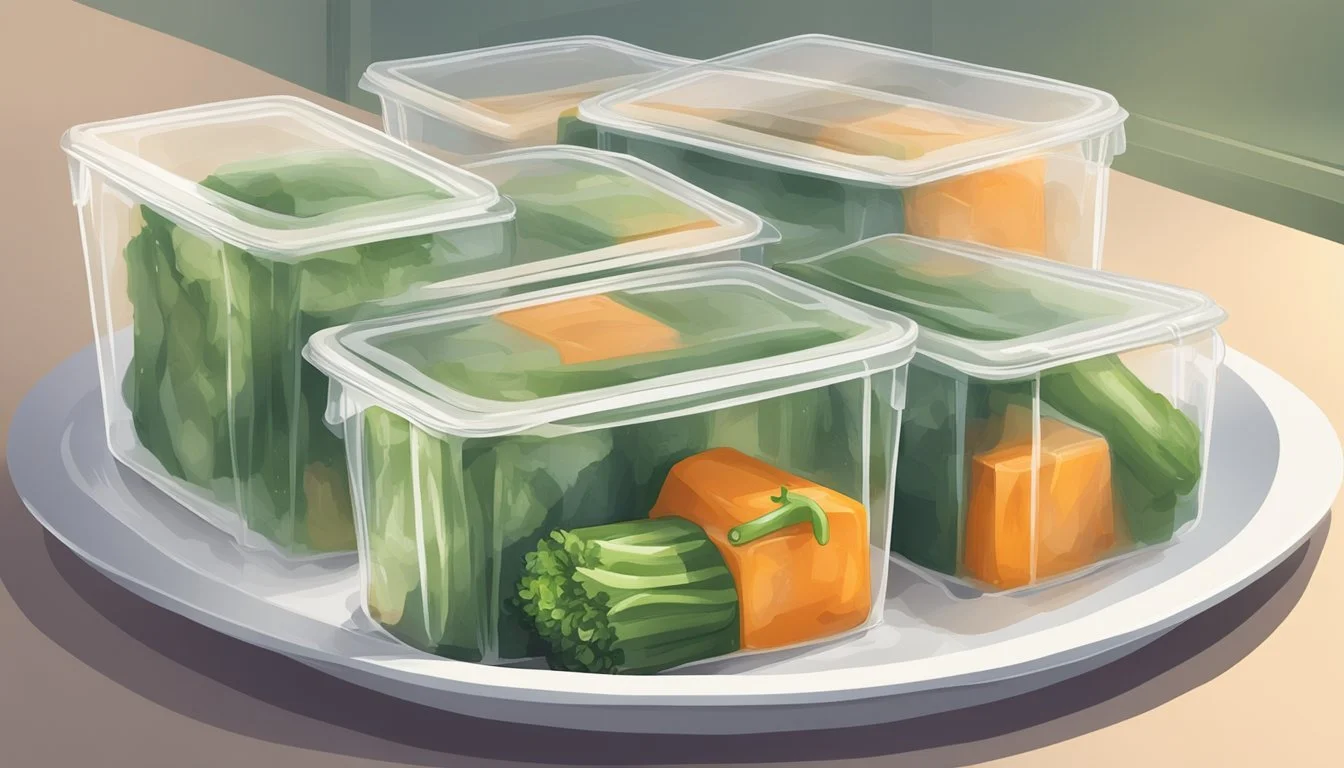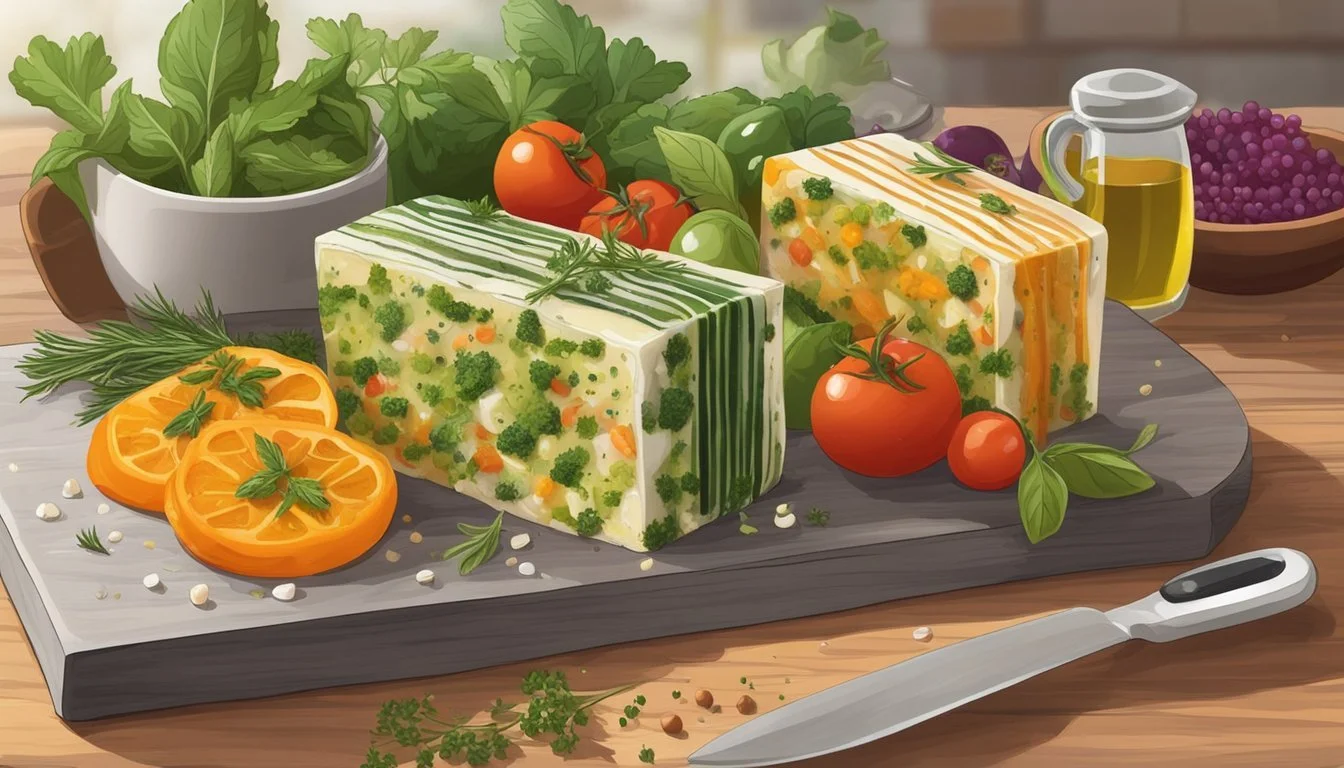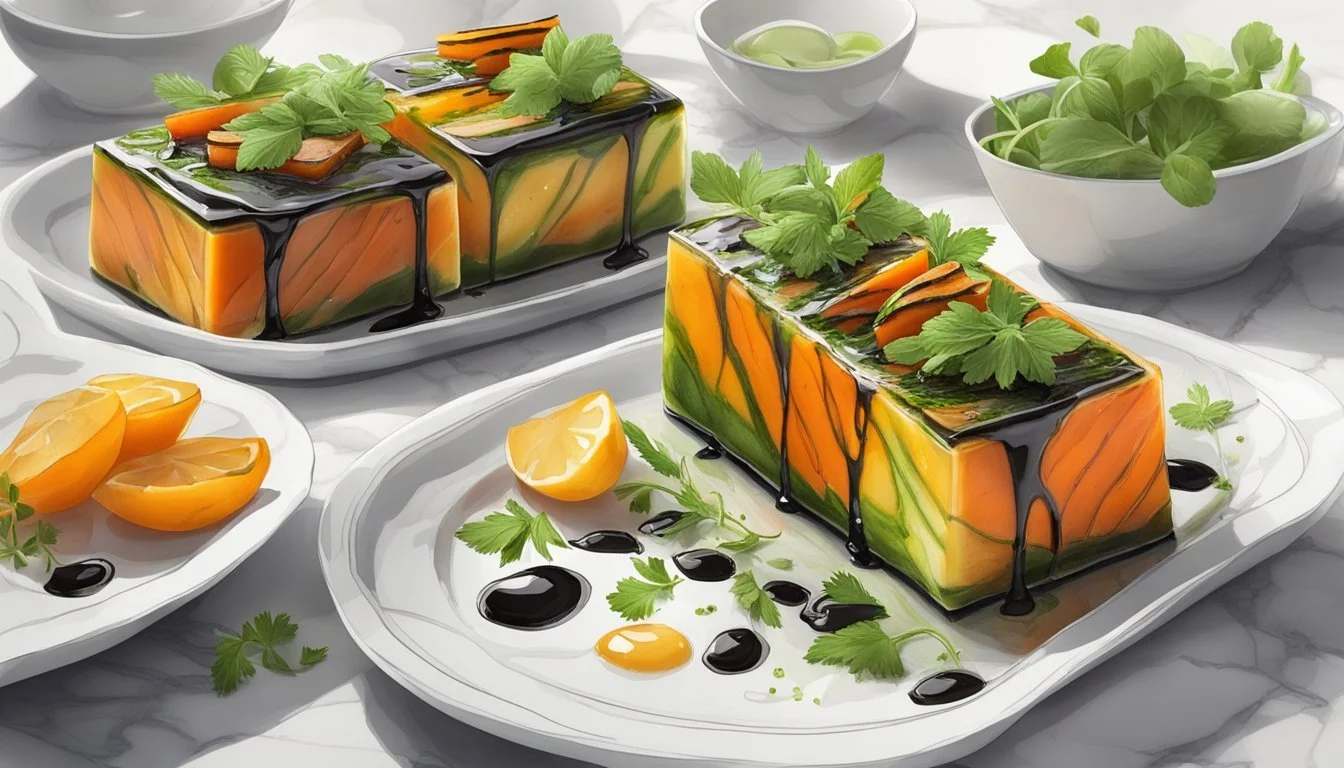How Long Do Freshly Prepared Vegetable Terrines Last?
Shelf Life and Storage Tips
When it comes to the preservation of freshly prepared vegetable terrines, understanding their shelf life is crucial for both food safety and quality. A vegetable terrine, often a symphony of layered vegetables, herbs, and sometimes cheeses or grains, can be a delightful addition to any meal. However, due to the variety of fresh ingredients involved, it is sensitive to spoilage and has a limited window of optimum freshness.
The longevity of a vegetable terrine in the refrigerator depends on the specific ingredients used and the conditions in which it was prepared and stored. On average, a well-prepared terrine can last around 3 to 5 days when kept at a consistent and safe temperature of 40°F (4°C) or below. This time frame ensures the dish maintains its flavor, texture, and, most importantly, food safety.
To maximize the lifespan of a vegetable terrine, it should be stored in an airtight container to prevent exposure to air and contaminants. It is also beneficial to store the terrine soon after it has been prepared, as prolonged exposure to room temperature can accelerate bacterial growth, reducing its shelf life and potentially making it unsafe to consume.
Understanding Vegetable Terrines
In the realm of culinary arts, vegetable terrines are both a visual delight and a testament to a chef's skill in assembling layers of cooked vegetables (how long do cooked vegetables last?) into a coherent, delicious dish. This section explores the essentials of vegetable terrines from their basics and key ingredients to the necessary equipment and the role of gelatin.
Terrine Basics
A terrine is a French dish traditionally made of layered meat, seafood, vegetables, or a combination thereof, set and served cold. Vegetable terrines, specifically, showcase layers of various vegetables which have been cooked, seasoned, and chilled in a mold to create a dense, sliceable consistency. Often, terrines are part of the aspic dish family but can also be vegetarian or vegan without the use of gelatin.
Key Ingredients for Vegetable Terrines
The predominant ingredients in a vegetable terrine are, unsurprisingly, vegetables. Here are common ones used:
Zucchini (What wine goes well with zucchini?)
Carrots
Bell peppers (What wine goes well with bell peppers?)
Leeks
Spinach (What wine goes well with spinach?)
Aside from fresh produce, lemon juice and seasoning such as salt, pepper, and herbs are vital for creating a flavorful terrine. In non-vegetarian versions, gelatin is used to set the terrine, which might be substituted with agar-agar in vegetarian terrines.
Terrine Equipment Essentials
To craft a proper terrine, specific kitchen tools are required. A standard food processor can be helpful in finely chopping ingredients or pureeing parts of the terrine for different textures. The most critical piece of equipment is the terrine mold, traditionally rectangular with straight sides. Additionally, heavy weights are necessary to press the terrine as it cools, compacting the mixture for the correct density.
Roles of Gelatin in Vegetable Terrines
Gelatin serves a pivotal role in non-vegetarian terrines; it acts as a binding agent that solidifies the layered ingredients when cooled, forming a gel-like structure known as aspic. However, in vegetarian terrines this role must be filled by non-animal derived gelling agents such as agar-agar. The use of these agents ensures that the sliced terrine holds together and maintains shape for an impressive presentation.
Preparing Your Terrine
When creating a vegetable terrine, meticulous preparation of ingredients and understanding proper layering techniques are critical for a successful dish. This attention to detail ensures that the vegetables are cooked just right, maintaining their vibrant colors and flavors.
Selecting and Preparing Vegetables
One should begin by assembling a variety of fresh vegetables such as zucchini (What wine goes well with zucchini?), carrots, leeks, eggplant (What wine goes well with eggplant?), asparagus, spinach, tomatoes, mushrooms, beets, and peas. Each vegetable requires careful cleaning and precise cutting for uniformity and presentation. Using a sharp knife or a mandoline guarantees evenly sliced vegetables, which not only cook uniformly but also create an attractive layered effect.
Zucchini: Thinly slice lengthwise after washing.
Carrots: Peel and cut into uniform strips.
Leeks: Clean thoroughly and slice into thin rings.
Eggplant: Slice into rounds and salt to remove bitterness.
Asparagus: Trim ends and blanch in boiling water.
Spinach: Wash and steam until wilted.
Tomatoes: Score, blanch, and peel for smooth layers.
Mushrooms: Clean with a brush and slice thinly.
Beets: Roast or boil until tender, then slice.
Peas: Blanch briefly to preserve their vibrant green color.
Layering Techniques
Layering the vegetables with precision is key to forming a cohesive terrine. Start with lining the mold, often a loaf pan, with plastic wrap or parchment paper for easy removal. As every layer is assembled, press gently to ensure no air gaps remain. Incorporating elements such as basil and garlic enhances the flavor profile. Alternate colors and textures to create a visually appealing design.
Example Layering Sequence:
Base layer: Eggplant slices overlapped at the base.
Second layer: A spread of spinach, seasoned with garlic and a hint of basil.
Third layer: Array of blanched carrot strips.
Continue with layers of leeks, zucchini, and any other chosen vegetables.
Setting and Cooling
Once layered, the terrine needs to set and cool to fuse the flavors and stabilize its structure. Covering the terrine with a lid or foil, it should be placed in a water bath and baked at a moderate temperature, around 350°F (177°C). The water bath ensures gentle, even cooking without drying out the delicate vegetables.
After baking, remove the terrine from the oven and allow it to cool at room temperature. Then, it should be transferred to a refrigerator to set completely. The cooling process is crucial as it enables the terrine to firm up, making slicing easier. The terrine typically requires several hours or better overnight in the refrigerator to achieve the right consistency.
Seasoning and Flavoring
Achieving the perfect balance of flavors in a vegetable terrine hinges upon the careful selection and application of seasonings. These enhance the natural tastes of the vegetables and contribute to the terrine's overall savoriness.
Salt and Pepper: The Foundation
The use of salt and pepper is fundamental in seasoning a vegetable terrine. Kosher salt is preferred for its clean taste and ability to dissolve easily, providing a consistent enhancement to the terrine's flavor profile. Black pepper, freshly ground, adds a slight heat and complexity that complements the varied flavors of the vegetables.
Herbs and Spices for Depth
Incorporating herbs and spices can significantly elevate the taste complexity of a terrine. Thyme and oregano offer an earthy and slightly peppery flavor, often used to accentuate the natural zest of the dish. For a more anise-like sweetness, tarragon works well, while parsley and chives (how long do chives last?) introduce a fresh, mild onion note. Each herb should be used judiciously to ensure they complement rather than overpower the vegetables.
Commonly used herbs include:
Thyme
Oregano
Tarragon
Chives
Parsley
Cheeses for Creaminess
The addition of cheese to a vegetable terrine can provide a creamy texture and a rich taste. Goat cheese is an excellent choice, imparting a tangy flavor that pairs well with the fresh vegetables. Cream cheese (how long does cream cheese last?) adds a smooth consistency, which can be enhanced with grated parmesan for a salty, nutty depth. A harmonious cheese blend can significantly contribute to the overall mouthfeel and taste of the terrine.
Popular cheese options:
Goat Cheese: Tangy and flavorful
Cream Cheese: Provides smoothness
Parmesan: Adds a salty, umami quality
Storage and Shelf Life
Freshly prepared vegetable terrines must be handled carefully to maintain their quality and safety. Proper refrigeration practices, the correct use of plastic wrap, and vigilance for signs of spoilage form the cornerstone of their storage and shelf life.
Optimal Refrigeration Practices
Fresh vegetable terrines should be refrigerated at temperatures between 35°F and 40°F as soon as they are prepared. They typically last for about 3 to 5 days if kept consistently cold. Fluctuations in temperature can hasten spoilage and degrade the texture and taste of the terrine. An airtight container is recommended to protect the terrine from absorbing odors and flavors from other foods in the refrigerator.
Using Plastic Wrap Correctly
To extend the freshness of a vegetable terrine, one should wrap it tightly in plastic wrap before placing it in a container. The plastic wrap helps to prevent air exposure and moisture loss, which are leading factors in the decline of the terrine's quality. It is crucial to ensure that the terrine is covered completely, leaving no part exposed.
Signs of Spoilage
A vegetable terrine that has gone bad will often present visible mold, discoloration, or sliminess. The presence of a sour or off-putting odor is also a clear indication that the terrine should no longer be consumed. Any changes in texture – such as a terrine becoming overly soft or mushy – should serve as a warning to discard the product. It is always better to err on the side of caution and dispose of a terrine if there is any doubt about its safety.
Serving Suggestions
When serving a vegetable terrine, the presentation and accompanying flavors are critical for creating a memorable dish. Ideal serving includes a careful balance of slicing, garnishment, and portion sizes, enhancing the terrine's fresh and healthy appeal.
Cutting and Plating
A sharp knife should be used to slice the terrine, ensuring consistent thickness for each serving—typically about half an inch to an inch. It is fundamental to wipe the blade between cuts to maintain a clean edge for aesthetic purposes. Plates should be drizzled with a high-quality olive oil to add a subtle richness, complementing the terrine's flavors.
Pairings and Garnishes
The terrine should be adorned with a light garnish that aligns with the flavors within. A sprinkle of fleur de sel can elevate the taste, while a handful of crushed walnuts offers a textural contrast. Adding garnishes not only contributes to the taste but also to the visual appeal; opt for vibrant, fresh herbs (how long do fresh herbs last?) or edible flowers for a touch of elegance.
Serving Sizes and First-Course Servings
For a healthy and flavorful dinner, serve the terrine as a first course in small portions. A segment of about two by four inches per person is ample. By keeping the servings modest, the terrine remains a delightful prelude that teases the palate without overwhelming it, making way for subsequent courses.
Advanced Techniques and Variations
When crafting a fresh vegetable terrine, chefs can elevate their dish through various advanced techniques and variations that enhance flavor, texture, and visual appeal.
Making Vegetarian Aspic
A vegetarian aspic can serve as a gelatinous component to hold the terrine together without using meat-based gelatin. To create a vegetarian aspic, one can dissolve powdered gelatin—made from agar-agar—in vegetable broth. Infuse the broth with fresh herbs and spices to complement the terrine's flavor profile. The use of a blender can help integrate the ingredients smoothly before the mixture is set.
Incorporating Different Textures
Textures play a crucial role in the enjoyment of vegetable terrines. Incorporating a variety of vegetables, such as diced red bell pepper, yellow bell pepper, and onion, provides crunch. Layering cooked vegetables, like blanched spinach or roasted eggplant, along with raw elements can create a contrast in textures. For added richness, chefs may include eggs or goat cheese between layers.
Creative Presentation Ideas
Presentation is key to making the terrine not only delicious but also visually stunning. Chefs can line their molds with parchment paper for easy removal, and use cardboard cutouts wrapped in foil as guides for layering ingredients. Alternating colors with different bell peppers or adding a layer of caramelized shallots can create visual stripes. Additionally, terrines can be served on a side dish, garnished with edible flowers or herb sprigs for a professional touch.







